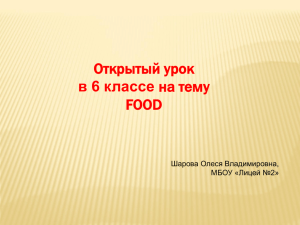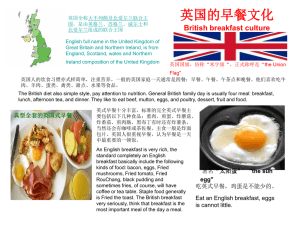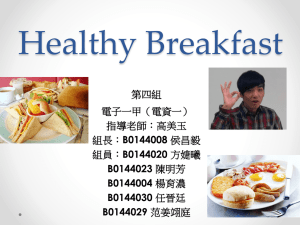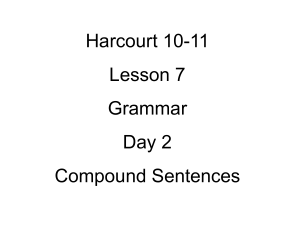Marketing plan of a rice-ball curbside restaurant
advertisement
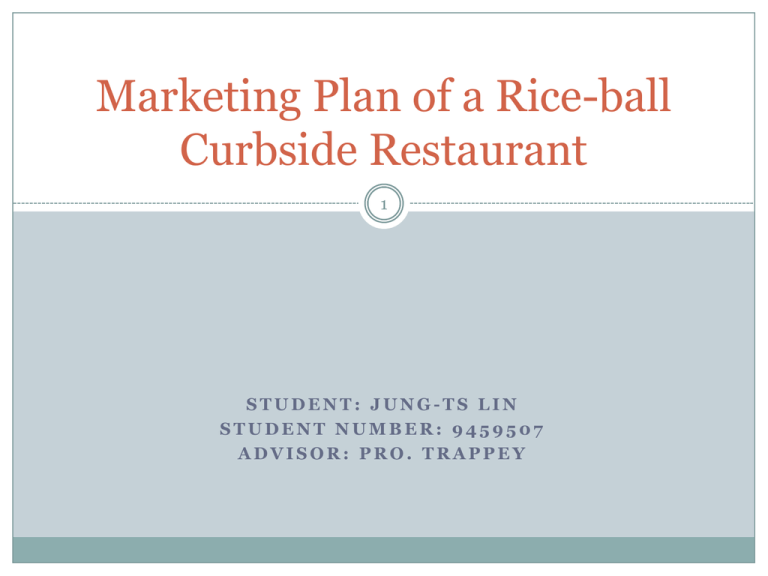
Marketing Plan of a Rice-ball Curbside Restaurant 1 STUDENT: JUNG-TS LIN STUDENT NUMBER: 9459507 ADVISOR: PRO. TRAPPEY OUTLINE 2 EXECUTIVE SUMMARY CURRENT MARKETING SITUATION Market Description Competitive Review STRENGHS, WEAKNESSES, OPPORTUNITIES, AND THREAT ANALYSIS MARKETING STRATEGIES Positioning Product strategy Pricing strategy BUDGETS CONTROLS EXECUTIVE SUMMARY 3 Energetic is a curbside restaurant selling Chinese breakfast; mainly rice balls and drinks. It is located near Xin Bu MRT station, Ban Ciao. The primary pricing strategy is to sell a combination of a rice ball and a drink for the purpose of ease calculation and quick service of handing out change. The primary financial objective is to break even in less than one year after operation. CURRENT MARKETING SITUATION 4 Most breakfast restaurants belong to the western style because the franchise organization provides full-blown logistics and hence reduces preparation for the operators. The Chinese breakfast restaurants offer alternatives except the western breakfast for the customers. However, Chinese breakfast restaurants have long been criticized in light of the sanitation of food resources and the process of making breakfast. CURRENT MARKETING SITUATION Market Description 5 More than three million Taiwanese do not eat breakfast at home; instead, they eat breakfast on the way, in the school, or in the office. People who eat breakfast outside mostly ages 20 to 24, followed by 25 to 29 and 30 to 34. More mothers become career women and too busy to make breakfast, so nowadays many children eat breakfast outside, too. CURRENT MARKETING SITUATION Market Description 6 Table 1 Target Customers, their needs, and the benefits provided Target customer College students Wage-earners Children Customer need A variety of rice balls and drinks to fulfill their pursuit of novelties Benefit Two varieties of rice balls and three varieties of drinks (coffee, tea, and soybean milk) with new flavors of rice balls du jour. A variety of co-branded food Lin Fong Ying milk, Mr. Brown resources to fulfill their pursuit of coffee, Chi Shang rice, soy taste bean milk of Homemaker’s Union and Foundation, etc. Nutrition that parents think good for Nutrient ingredients like eggs their children’s health of Homemaker’s Union and Foundation, Hai Di Ji tuna, Hisn Dong Yang powdered meat, and Da Bei pickle CURRENT MARKETING SITUATION Market Description 7 Rice ball Tea Coffee Soybean milk Figure 1 Varieties of Food Provided by Energetic CURRENT MARKETING SITUATION Market Description 8 Lin Fong Ying milk Mr. Brown coffee Chi Shang rice Egg of Homemaker’s Union and Foundation Hai Di Ji tuna Da Bei pickle Figure 2 Co-branding Soy bean milk of Homemaker’s Union and Foundation CURRENT MARKETING SITUATION Competitive Review 9 The main competitor is Yong He soy bean milk, which is the biggest franchise organization of Chinese breakfast in the country. The strengths of Yong He soy bean milk are as follows: (1) Providing various options of breakfast, such as salty soy bean milk, pork pie, steamed buns, and others (see pictures below) (2) Having well-known brand awareness Salty soy bean milk Pork pie Steamed buns Figure 3 Food Provided by Yong He soy bean milk CURRENT MARKETING SITUATION Competitive Review 10 Although Yong He soy bean milk has the strengths, it does not have clear sanitary standards to ensure the uniformity of its branches’ environments and the process of producing food. Therefore, Energetic can focus on providing sanitary food for customers and clean environments for dining since these two criteria have been valued by consumers in recent years. STRENGHS, WEAKNESSES, OPPORTUNITIES, AND THREAT ANALYSIS 11 Table 2 Energetic’s strengths, weaknesses, opportunities, and threat SWOT Strengths Weaknesses Opportunities Threat Points Use branded food materials Offer good taste and sanitation Lack a variety of options, better services, and great brand awareness People do not have much time to make breakfast Have only one main competitor Yang He soy bean milk Good location Pricy oil increases the expenses of transportation MARKETING STRATEGIES 12 Energetic rice-ball curbside restaurant is different from other rice-ball curbside restaurants because it knows customers’ needs and wants. It also analyzes its’ strengths, weakness, opportunities, and threat in the breakfast market. Its marketing strategies can be established in terms of positioning, product strategy, and pricing strategy. MARKETING STRATEGIES Positioning 13 Energetic is a rice-ball curbside restaurant, caring for everyone’s stomach in the morning. It offers quality breakfast to customers by co-branding. In addition, it offers sealed drinks in avoidance of spilling for the take-to-go customers and delivery service of large amount of orders. Therefore, Energetic can build up the image of quality products, higher levels of sanitation, and better service in customers’ mind. MARKETING STRATEGIES Product strategy 14 The co-branded food materials and sealed drinks satisfy most customers’ needs. Moreover, the new flavors of rice balls can provide more options and keep attracting customers. In order to strengthen the brand awareness, the brand and slogan will be displayed on the wrapping paper, cups, and bags. MARKETING STRATEGIES Product strategy 15 The brand and slogan is as below: Caring for your stomach every morning MARKETING STRATEGIES Pricing strategy 16 The items provided include two varieties of rice balls, three varieties of drinks, and new flavors of rice balls du jour. Each item is sold NT 25 dollars. Energetic will focus on promoting combos; that is, a combination of a rice ball and a drink. The purpose of selling combos is to simplify calculation and hand out change quickly. Nonetheless, the customers can also choose singles. customers can choose to add milk to their drinks or add fried bread sticks, powdered meat, or pickle to their rice balls with the same price. BUDGETS 17 Energetic runs six days per week and it assumes to have 19 good days and five bad days in a month. In good days, the curbside restaurants are very likely to sell out 100 combos per day, while in bad days, they only sell out 20 combos per day. The sales of combos and singles in good or bad days are fifty-fifty. The estimated fixed cost in total is NT 25,000 dollars, the loan interest is 5 % BUDGETS 18 The monthly revenue of the curbside restaruant is as below: (50+25) X 10 X 5=3750 —bad days (50+25)X 50 X (6X4-5)=71,250 —good days 3750+71250=75,000 —the monthly revenue BUDGETS 19 The break-even point can be reached when the total revenue equals the total cost (variable cost + fixed cost). In this case, the total revenue per month is NT 75,000 dollars. The variable cost is half of the total revenue: 75,000 X 0.5= 37,500 –variable cost per month If Energetic can break even in N months, the equation is: 75,000 X N = 37,500 X N + 25,000 X (1+ 5%) N = 1.4 In other words, it takes Energetic less than 2 months to break even. Moreover, the profit = the total revenue – total cost, so the profit Energetic can get at the end of year one is: 75,000 X 12 – [37,500 X 12 + 25,000 X (1+ 5%)] = 423, 750 The profit at the end of year one is NT 423, 750 dollars. CONTROLS 20 During the first-week operation, Energetic can measure its performance by field observation and questionnaire survey in order to understand customer satisfaction. Energetic can give a coupon worth of NT 25 dollars to the customers who have filled out the questionnaire. CONTROLS 21 Other methods can be used to measure return on marketing (marketing ROI) in the long run, such as monthly sales, monthly expenses, market share, trial rate, customer retention, and even customer lifetime values. (1) Monthly sales and monthly expenses can help Energetic examine the profits it earns. (2) The market share can facilitate Energetic to understand its brand awareness (A large market share can be resulted from high brand awareness) and consider whether to provide more options to the existing customers or to sell products to different market segments. CONTROLS 22 The trial rate and customer retention can give information about brand image and customer satisfaction. For example: If a customer regards Energetic as a quality curbside restaurant due to its co-branding (brand image), he may try to buy breakfast in Energetic once (trial). If his experience of “Energetic breakfast” is good, it is very likely that he frequents this curbside restaurant (customer retention). As long as Energetic offers delightful purchasing experience for consumers, it is easier to establish a lifetime relationship with customers and capture customer lifetime values. 23 THANK YOU
